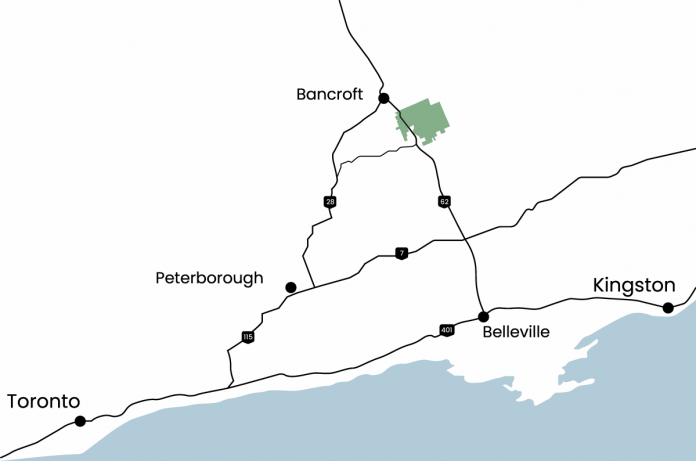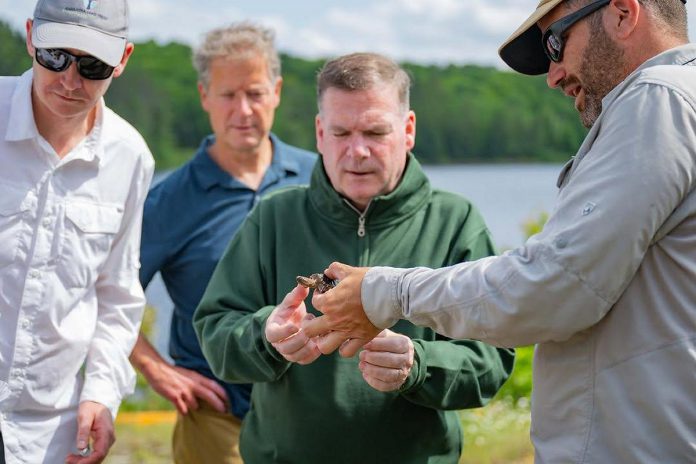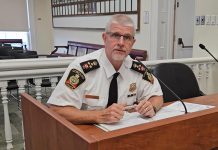
A 26,300-acre tract of land just south of Bancroft in North Hastings has become the largest protected area owned by an individual in Canada.
In June 2021, Land’escapes — owned by Ben Samann, who also owns Viamede Resort in Woodview — purchased the property from U.S.-based forestry company The Forest Land Group.
Samann’s vision was to conserve, restore, and conduct leading-edge research on the property while also using it as a backcountry wilderness park — called, simply, ‘The Park’ — for camping, hiking, and other low-impact recreational activities.
In partnership with the Ontario Conservation Accelerator, a group of conservation experts (including former Kawartha Land Trust executive director Mike Hendren) committed to accelerating conservation in Ontario, Samann’s property has now been recognized as a protected area by both the Governments of Ontario and Canada.
The property has been added to Canada’s protected and conserved areas database, which tracks progress toward Canada’s target of protecting 30 per cent of its lands and waters by 2030 (in Ontario, 10.9 per cent of land is now formally recognized as protected or conserved).
The Ontario Conservation Accelerator is working to accelerate the pace and scale of land conservation by pursuing public and private partnerships that don’t require a conservation entity or government to acquire title or rights to the land.

“The Ontario Conservation Accelerator is proud to partner with Ben Samann in recognizing his stunning and biodiverse property in Central Ontario,” said Ontario Conservation Accelerator managing director Kristyn Ferguson in a media release. “The idea of even one undeveloped lake is astounding to most people in southern Ontario, and this property contains twenty of them.”
Along with 20 completely undeveloped lakes, The Park contains over 5,000 acres of wetland and supports 13 species at risk, including the Canada warbler and Blanding’s turtle, and well as wide-ranging mammals including moose, bear, and elk.
The announcement of The Park’s status of a protected area was made at a media event and property tour on Tuesday (June 17) attended by representatives from the Ontario government, the Ontario Conservation Accelerator, Land’escapes, and a variety of other conservation partners and supporters.
“We’re deeply grateful to the Government of Ontario and the Government of Canada for their crucial support in making this important project possible,” Ferguson said. “It’s an honour to be on the land today celebrating this extraordinary achievement alongside so many dedicated partners and supporters.”
According to the Ontario Conservation Accelerator, The Park plays a vital role in protecting two of Ontario’s most important wildlife corridors — The Land Between corridor and the Algonquin to Adirondack corridor — and will serve as an anchor for future conservation efforts in the region.
“It’s really lovely to work with a property like this, to get to explore and enjoy its natural beauty, while having its role in the conservation landscape recognized,” Samann said. “The team at the Ontario Conservation Accelerator have been a huge resource for this property, from general advice to moral support to taking on the task of working directly with the Government of Ontario to have the land recognized as protected.”

Ontario’s minister of the environment, conservation and parks Todd McCarthy attended Tuesday’s media event and property tour along with Hastings-Lennox & Addington MPP Ric Bresee. Both politicians helped to release a clutch of baby snapping turtles into the wild with the help of the Ontario Turtle Conservation Centre.
“This remarkable achievement is a testament to the leadership and dedication of individual land stewards like Ben Samann, whose commitment to conservation is helping safeguard Ontario’s natural heritage,” McCarthy said.
“Our government is proud to support this work, which is a wonderful example of the great things that are possible when individuals, communities, and governments work together. I commend Ben and all the partners involved on this inspiring model of environmental stewardship that will benefit generations to come.”
According to the Ontario Conservation Accelerator, a variety of mechanisms will ensure the long-term conservation of The Park.
These include a conservation-focused property management plan, a conservation-focused forest management plan, municipal zoning recognizing environmentally sensitive and significant wildlife areas, partnerships with conservation and research entities, and long-term planning for the property’s ownership beyond the life of the current owner.
The Park will also be the site for a massive, long-term research partnership with the University of Guelph to answer key questions about the species, habitats, watersheds, and geology of the site. The lands will also be available for access by Indigenous people upon request.



























